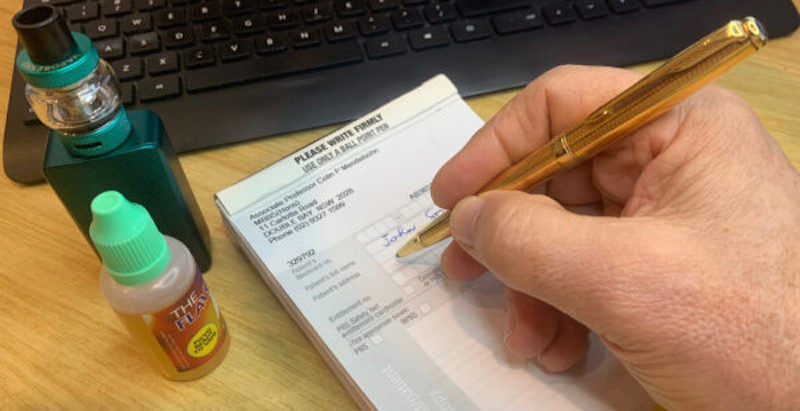The Australian government’s medical, prescription-only model for nicotine vaping was introduced on October 1, 2021, and has been a resounding policy failure. Like most prohibitionist policies, it has created a thriving illicit market and detrimental public health outcomes.
To legally possess nicotine e-liquid to quit smoking, vapers must get a doctor’s prescription and purchase supplies from pharmacies or international online vendors. The sale of nicotine from vape shops and other retail outlets is banned.
Predictably, this prohibitionist model has created a thriving illicit market.
The regulations were intended to prevent youth vaping and to allow access for adults as a smoking cessation aid. After 12 months, it is clear that they have achieved neither of those goals. In fact, they have had the opposite effect, as my new report indicates.
Illicit Market, Raids and Increased Youth Vaping
Predictably, this prohibitionist model has created a thriving illicit market for unregulated vaping products that do not comply with Australian standards. Massive numbers of poor-quality devices are being imported from China and are widely sold by tobacconists, convenience stores, online and on social media. Criminal organizations are becoming increasingly involved.
Enforcement of the illicit market is minimal, but some businesses are raided. When that happens, many just resume selling illegal products within weeks. The vast majority of illegal imports are not detected.
The widespread availability of disposable nicotine vapes on the illicit market has left consumers less protected and devastated the legal retail vape industry—which continues to sell hardware and nicotine-free liquids, but is not allowed to sell nicotine. Many shops have reported a substantial decline in sales and some have closed as a result. As many vapers are now buying illegal nicotine disposables, these retail products are now being used far less. (Previously vapers bought their nicotine-free liquid locally and added nicotine from overseas, or just bought hardware locally and premixed nicotine juice from overseas. Now many do neither.)
Schools are responding by installing vape detectors and confiscating vapes.
Vaping by adolescents has reportedly increased in Australia since the new regulations began. There are almost daily media reports of widespread youth vaping. High-nicotine (5 to 6 percent) disposable vapes are freely sold on the illicit market. With no age controls in an unregulated market, they are easily accessible by teens from tobacconists, convenience stores, gas stations and even in Ubers. Devices are easily purchased on social media, often with a home delivery service.
There are also increasing reports from schools of teens vaping in bathrooms and the classroom. Some schools are responding by installing vape detectors in the toilets, removing toilet doors, locking toilets during class hours, installing security cameras, suspending students for vaping at school and confiscating vapes.
Reduced Access for Adults
The prescription model has made it harder for adults who smoke to legally access nicotine vapes to quit smoking. Legal access is complex, onerous and costly. Perversely, it is far easier to buy deadly cigarettes.
According to two recent surveys, between 88 to 97 percent of vapers do not have a prescription and only 2 percent of purchases are made from a pharmacy, the government’s preferred model. However, it is a criminal offense to possess nicotine without a prescription, punishable by fines up to $45,000 and potential jail terms.
Only 200 out of 31,000 general practitioners were publicly listed as nicotine prescribers.
Doctors have not supported the regulations. In June 2022, only 200 out of 31,000 general practitioners (GPs) were publicly listed as nicotine prescribers. GPs cannot advertise their availability for nicotine prescribing, so it very difficult for vapers to find a prescriber.
GPs are skeptical about vaping and are reluctant to prescribe nicotine. They are constantly exposed to negative messaging by the Therapeutic Goods Administration (Australia’s medicines regulator), government agencies, medical associations and colleges, health charities and the mainstream media. GPs also fear medico-legal repercussions for prescribing unapproved products, and no vaping products are approved by the medicines regulator. GPs know very little about vaping, and most do not know how to write a nicotine prescription.
Only a handful of community and online pharmacies dispense nicotine liquid. Those that do stock nicotine products have a very small range to choose from.
Admit the Mistake
The only way forward is to replace the prescription-only model and the illicit market it fosters with a legal and regulated retail market. Nicotine liquid should be an adult consumer product, sold from licensed retail outlets such as vape shops, convenience stores, tobacconists and general stores as it is in other countries. There should be strict age verification and penalties up to loss of license for underage sales.
It would be worthwhile having a dual pathway, however with both consumer and medically approved products which doctors can prescribe. This would legitimize vaping for doctors and reassure them and the public about safety concerns.
Australia’s misguided experiment has failed. We need to admit the mistake and adopt a more realistic regulatory model to support Australians who smoke and vape.
Photograph via ColinMendelsohn.com.au





Show Comments